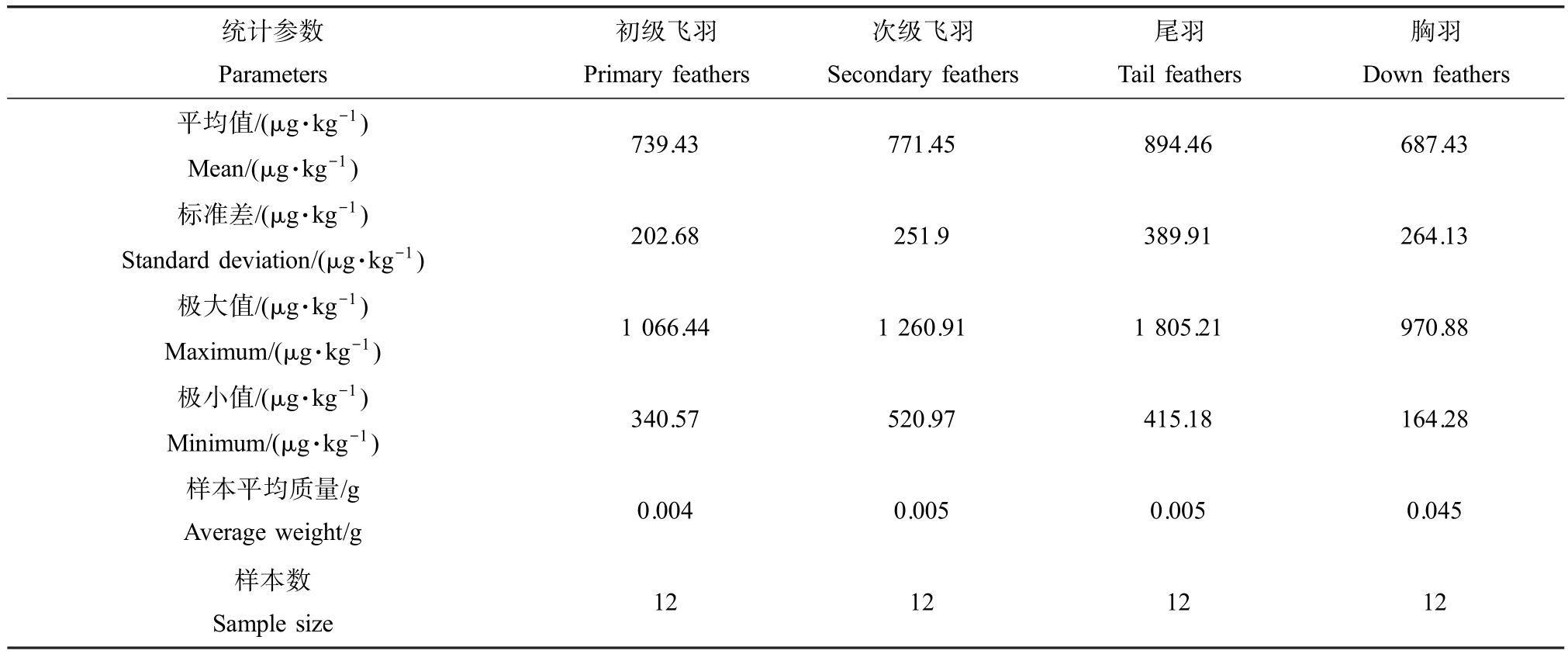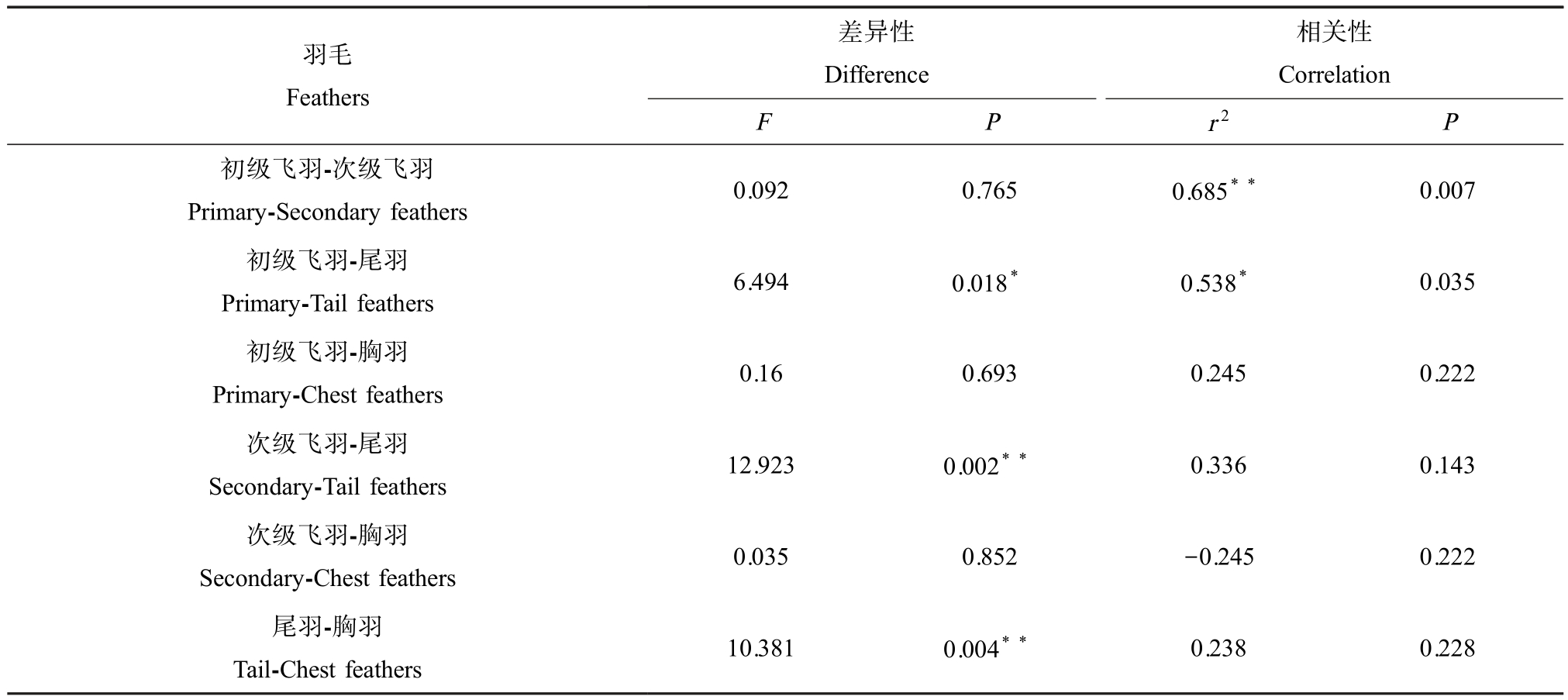汞作为一种全球分布的持久性污染物,具有强烈的生物毒性,能对人类和野生动物产生严重危害[1-2]。 汞对鸟类的影响也受到广泛关注。 鸟类长期接触汞会对其繁殖、行为和生存产生严重影响[3-4]。 例如,卵中汞残留超过1.8 μg·kg-1能够导致卵质量下降、畸形以及孵化率、生长率和雏鸟成活率的降低[5]。 汞可能是导致冬季迁徙海鸟大规模死亡的重要因素[6]。 甲基汞还会影响鸟类的警戒行为,从而增加被捕食风险[7]。 因此,充分了解汞污染对鸟类的影响对维持生态系统平衡具有重要意义。
鸟类是生态系统的重要组成部分,与环境关系十分密切,是较好的环境质量监测指示生物[8-9]。 雀形目鸟类在鸟纲中类群最为丰富,野外种群数量多,样本易于采集;同时雀形目留鸟的活动范围小且相对稳定,不仅能反映当地的环境污染状况,还可以揭示当地的环境变化对人类健康产生的影响。 近年来,越来越多的生态毒理学家推荐使用雀形目留鸟监测环境重金属污染[10-12]。
灰眶雀鹛(Alcippe morrisonia)是广泛居留于中国西南和亚洲南部森林中的雀形目鸟类,以多种昆虫为食,数量丰富,易于研究和采集[13-14]。 灰眶雀鹛在鸟类混合群中常被视为“核心种”,经常带领混合群中的鸟类进行觅食和警戒[15-16],因此研究汞污染对灰眶雀鹛的影响可能对了解森林鸟类群落的维持具有重要意义。 本文分析了广西大新铅锌矿废弃矿区周边灰眶雀鹛初级飞羽、次级飞羽、尾羽和胸羽中的汞含量及分布特征,以检验灰眶雀鹛作为环境污染指示物种的可行性,以及何种类型的羽毛能较好地反映当地的汞污染水平。 同时,也将为研究汞污染对森林鸟类群落的影响提供科学依据。
1 材料与方法(Materials and methods)
1.1 研究区域概况
大新铅锌矿区(22°58′15″N,107°17′28″E)位于广西大新县三合村,海拔418 m。 该地区属于亚热带海洋性季风气候,潮湿多雨。 矿区从1955年正式开采,开采期长达40 余年,2001年底,因环境污染和资源枯竭,停止开采[17]。 原矿区生产期间,对采矿产生的废水、尾矿未得到有效处理,使矿区周边的水土和农作物受到严重的重金属污染,也严重影响了野生动物及周边部分群众的身体健康。
1.2 样品采集与汞测定
2018年1月,采用雾网法[18]在废弃矿区周边的森林中对灰眶雀鹛进行抓捕采样,共捕获灰眶雀鹛成鸟12 只。 采样点位于废弃矿区的排水池约50 m处,由于喀斯特地表水较少,该水源几乎为该区域野生动物的唯一永久性地表水源。 捕获后,收集其初级飞羽、次级飞羽、尾羽和胸羽,取样完成后将其放飞。
本研究测得的汞含量均为样本的总汞浓度。 鸟类羽毛中富集的汞90%以上是总汞[19],因此,检测总汞可以代表鸟类的污染水平。 对羽毛样本进行编号后,再用丙酮、蒸馏水、去离子水对羽毛进行清洗,以去除外源污染物,然后置于温度为60 ℃的恒温烘干箱中进行烘干;羽毛样本用电子天平(精度为0.001 g)进行称量,放入到DMA-80 直接测汞仪(意大利Milestone 公司)中进行检测,其最低检出限为0.2 μg·kg-1。
1.3 质量控制
采用标准曲线、空白对照和标准物质(IAEA-086)对试验过程进行质量控制,同时每检测10个羽毛样本后检测一次标准物质,以确保数据的精确性。空白检测结果为0.00 μg·kg-1。 总汞标准物质为人发(IAEA-086),参考值为534 ~612 μg·kg-1,仪器检测结果为(597.46±63.55) μg·kg-1(n=5),在正常范围内,羽毛样品检测结果可靠。
1.4 数据分析
对所有灰眶雀鹛羽毛的汞浓度值进行单样本K-S 检验,符合正态分布后,对4 种羽毛的汞浓度值进行单因素方差分析和Spearman 相关分析,数据分析均使用SPSS 20.0 完成。
2 结果与讨论(Results and discussion)
2.1 灰眶雀鹛羽毛样品中汞的残留量
灰眶雀鹛尾羽样品中的汞浓度为415.18~1 805.21 μg·kg-1,平均汞浓度为(894.46±389.91)μg·kg-1;次级飞羽样品中汞浓度为520.97~1 260.91 μg·kg-1,汞浓度均值为(771.45±251.90) μg·kg-1;初级飞羽样品中汞浓度340.57 ~1 066.44 μg·kg-1,平均汞浓度为(739.43±202.68) μg·kg-1;胸羽样品中汞浓度为 164.28 ~ 970.88 μg·kg-1,汞浓度均值为(687.43±264.13) μg·kg-1 (表 1)。
表1 灰眶雀鹛4 种羽毛中汞浓度
Table 1 Mercury levels in four kinds of feathers of Grey-cheeked Fulvettas

统计参数Parameters初级飞羽Primary feathers次级飞羽Secondary feathers尾羽Tail feathers胸羽Down feathers平均值/(μg·kg-1)Mean/(μg·kg-1) 739.43 771.45 894.46 687.43标准差/(μg·kg-1)Standard deviation/(μg·kg-1) 202.68 251.9 389.91 264.13极大值/(μg·kg-1)Maximum/(μg·kg-1) 1 066.44 1 260.91 1 805.21 970.88极小值/(μg·kg-1)Minimum/(μg·kg-1) 340.57 520.97 415.18 164.28样本平均质量/g Average weight/g 0.004 0.005 0.005 0.045样本数Sample size 12 12 12 12
单因素方差分析检验结果显示,灰眶雀鹛尾羽中的汞浓度值显著高于其他3 种羽毛样品(表2),但初级飞羽、次级飞羽和胸羽之间无显著差异。Spearman 相关性分析结果显示(表2),灰眶雀鹛尾羽与初级飞羽(r 2=0.538,P=0.035)以及次级飞羽与初级飞羽(r 2=0.687,P=0.007)样品中汞浓度呈显著相关性。 汞在灰眶雀鹛羽毛中的富集模式为:尾羽>次级飞羽>初级飞羽>胸羽。 本研究结果与其他研究结果基本一致[20-21]。 鸟类体内的汞多通过食物摄取,在生长过程中,体内积累的汞会释放到羽毛里,与羽毛中的角蛋白牢固结合,并通过周期性换羽将体内积累的汞排出体外,这是大多数鸟类排出汞的有效机制[22]。 灰眶雀鹛4 种羽毛中汞的分布规律有所不同,可能与换羽季节及换羽顺序的不同有关。研究发现,同为雀形目鸟类的黄腹山鹪莺(Prinia flaviventris)和纯色山鹪莺(Prinia inornata)每年都换羽2次,分别在春季和秋季,其中秋季换羽为完全换羽,时间是8月到12月,尾羽的换羽时间要晚于初级飞羽和次级飞羽,次级飞羽的换羽时间晚于初级飞羽,2 种鸟的换羽模式基本相似[23-24]。 由于分类地位较为接近,该换羽模式可以作为灰眶雀鹛换羽模式的参考。 尾羽换羽时间相对较晚,因此,尾羽可能会富集更多的汞,这种换羽模式可能是造成汞在灰眶雀鹛羽毛中分布不同的原因。
表2 灰眶雀鹛4 种羽毛间汞浓度差异性及Spearman 相关性分析
Table 2 Difference and Spearman correlation analysis of mercury levels in four types of feathers from Grey-cheeked Fulvettas

注:*P<0.05、** P<0.01 表示显著相关。
Note: *P<0.05, **P<0.01 represent significant correlation.
羽毛Feathers差异性Difference相关性Correlation F P r 2 P初级飞羽-次级飞羽Primary-Secondary feathers 0.092 0.765 0.685* * 0.007初级飞羽-尾羽Primary-Tail feathers 6.494 0.018* 0.538* 0.035初级飞羽-胸羽Primary-Chest feathers 0.16 0.693 0.245 0.222次级飞羽-尾羽Secondary-Tail feathers 12.923 0.002* * 0.336 0.143次级飞羽-胸羽Secondary-Chest feathers 0.035 0.852 -0.245 0.222尾羽-胸羽Tail-Chest feathers 10.381 0.004* * 0.238 0.228
2.2 与其他雀形目鸟类相比
不同鸟种对汞的富集程度存在差异。 邹发生等[25]测定了广东白云山地区白头鹎(Pycnonotus sinensis)羽毛、肝脏和肌肉中汞的残留量,汞在白头鹎各组织中的平均值分别为499、158 和1 μg·kg-1;张培勤和周英梅[26]分析了太原南郊区树麻雀(Passer montanus)初级飞羽、次级飞羽、背羽、腹羽、尾羽和胸肌中的汞浓度,汞在6 种组织中平均含量分别为262.8、233.3、212.4、189.0、218.1 和 30.14 μg·kg-1。与山西太原和广东白云山地区相比,广西大新地区灰眶雀鹛羽毛中富集更高浓度的汞。 Costa 等[27]研究了工业区周边森林中大山雀(Parus major)成鸟羽毛和粪便中的汞残留量。 与灰眶雀鹛相比,其平均汞含量较低。 与Tsipoura 等[28]的研究相比,灰眶雀鹛尾羽中平均汞浓度也高于红翅黑鹂(Agelaius phoeniceus)。 鸟类组织中的重金属浓度可以反映出鸟类所处环境中重金属背景值的高低[24]。 广西大新铅锌矿区地表水中汞浓度为0.077 μg·kg-1,土壤中汞浓度高达5.762 μg·kg-1,超过《土壤环境质量标准》(GB 15628—2018)的 11.3 倍[29],因此,灰眶雀鹛羽毛中较高的汞浓度可能与当地环境背景值有关。
2.3 灰眶雀鹛与汞污染监测
灰眶雀鹛是中国西南部和亚洲南部森林中常见的留鸟,活动范围小,食性多样,以多种昆虫为食[13],处于食物链中较高的位置,其体内的汞可通过生物放大在体内富集。 灰眶雀鹛是食虫性鸟类,与其他植食性鸟类相比,食虫鸟类对汞具有较强的富集能力[30],使用灰眶雀鹛监测亚热带森林中的汞污染具有一定的可行性。 灰眶雀鹛尾羽中汞浓度显著高于其他3 类羽毛,且尾羽中的汞浓度与初级飞羽呈显著正相关,与胸羽中汞浓度也呈现负相关趋势。 因此,尾羽可能是监测鸟类汞污染的最佳选择。 尽管灰眶雀鹛羽毛中的汞浓度(1.8 μg·g-1)没有达到影响繁殖的阈值(5 μg·g-1)[31],但是,汞污染对鸟类行为的影响也同样重要。 对于小型雀形目鸟类,即使汞浓度(3 μg·g-1)低于阈值也会对身体状况产生不良影响[32]。 同样,汞污染还会增加鸟类的冒险行为[33]。 灰眶雀鹛作为热带和亚热带森林中鸟类混合群的“核心种”,对鸟类混合群落起到凝聚作用[34],该区域较高的汞污染是否影响到灰眶雀鹛的领导和警戒行为尚有待于进一步研究。
[1]Abeysinghe K S, Qiu G L, Goodale E, et al. Mercury flow through an Asian rice-based food web [J]. Environmental Pollution,2017,229:219-228
[2]朱艾嘉, 许战洲, 柳圭泽, 等. 黄海常见鱼类体内汞含量的种内和种间差异研究[J]. 环境科学, 2014, 35(2):764-769
Zhu A J, Xu Z Z, Liu G Z, et al. Inner- and inter-species differences of mercury concentration in common fishes from the Yellow Sea [J].Environmental Science,2014,35(2):764-769 (in Chinese)
[3]Cristol D A,Mojica E K,Varian-Ramos C W,et al.Molted feathers indicate low mercury in bald eagles of the Chesapeake Bay, USA [J]. Ecological Indicators, 2012,18:20-24
[4]Seewagen C L. Threats of environmental mercury to birds: Knowledge gaps and priorities for future research[J]. Bird Conservation International,2010,20(2):112-123
[5]Burger J, Gochfeld M. Risk, mercury levels, and birds:Relating adverse laboratory effects to field biomonitoring[J]. Environmental Research,1997,75(2):160-172
[6]Fort J,Lacoue-Labarthe T,Nguyen H L,et al.Mercury in wintering seabirds, an aggravating factor to winter wrecks? [J]. The Science of the Total Environment,2015,527-528:448-454
[7]Heinz G H. Methylmercury: Reproductive and behavioral effects on three generations of mallard ducks [J]. The Journal of Wildlife Management,1979,43(2):394
[8]Markowski M,Kaliński A,Skwarska J,et al.Avian feathers as bioindicators of the exposure to heavy metal contamination of food [J].Bulletin of Environmental Contamination and Toxicology,2013,91(3):302-305
[9]Eens M, Pinxten R, Verheyen R F, et al. Great and blue tits as indicators of heavy metal contamination in terrestrial ecosystems [J].Ecotoxicology and Environmental Safety,1999,44(1):81-85
[10]潘超, 郑光美, 张正旺, 等. 北京城区麻雀体内污染物的研究[J]. 北京师范大学学报: 自然科学版, 2001, 37(6):820-824
Pan C, Zheng G M,Zhang Z W,et al.Studies on contaminations in tree sparrow (Passer montanus) in Beijing [J].Journal of Beijing Normal University: Natural Science,2001,37(6):820-824 (in Chinese)
[11]邹发生, 杨琼芳, 谢美琪. 广州市白云山4 种雀形目鸟类重金属残留分析[J]. 农村生态环境, 2005, 21(1): 51-54
Zou F S, Yang Q F, Xie M Q. Heavy metal residues in tissues of four species of Passeriformes at Baiyunshan,Guangzhou City,China[J].Rural Eco-Environment,2005,21(1):51-54 (in Chinese)
[12]Dauwe T,Lieven B,Ellen J,et al.Great and blue tit feathers as biomonitors for heavy metal pollution [J]. Ecological Indicators,2002,1(4):227-234
[13]Jiang A W, Zhou F, Liu N F. Significant recent ornithological records from the limestone area of south-west Guangxi, South China,2004-2012 [J]. Forktail,2014(30):122-129
[14]Zou F S,Lim H C,Marks B D,et al.Molecular phylogenetic analysis of the Grey-cheeked Fulvetta (Alcippe morrisonia)of China and Indochina:A case of remarkable genetic divergence in a “species” [J]. Molecular Phylogenetics and Evolution,2007,44(1):165-174
[15]Chen C C, Hsieh F. Composition and foraging behaviour of mixed-species flocks led by the Grey-cheeked Fulvetta in Fushan Experimental Forest, Taiwan, China [J]. Ibis,2002,144(2):317-330
[16]Shieh B. Song structure and microgeographic variation in a population of the Grey-cheeked Fulvetta (Alcippe morrisonia) at Shoushan nature park, southern Taiwan, China[J]. Zoological Studies,2004,43:132-141
[17]吕晶晶, 张新英, 吴玉峰, 等. 广西大新县铅锌矿区某屯耕地土壤重金属污染特征及评价[J]. 广西师范学院学报: 自然科学版,2013,30(4):51-54
Lv J J, Zhang X Y, Wu Y F, et al. Characteristics and assessment of heavy metal pollution in the arable soil from the village of Daxin lead zinc mining area [J]. Journal of Guangxi Teachers Education University: Natural Science Edition,2013,30(4):51-54 (in Chinese)
[18]邹发生, 陈桂珠. 雾网在森林鸟类群落研究中的应用[J]. 应用生态学报,2003,14(9):1557-1560
Zou F S, Chen G Z. Application of mist net in studies of forest bird communities [J]. Chinese Journal of Applied Ecology,2003,14(9):1557-1560 (in Chinese)
[19]Ma Y J, Zheng W, An Y X, et al.Mercury contamination in terrestrial predatory birds from Northeast China: Implications for species and feather type selection for biomonitoring [J]. Ecological Indicators,2021,130:1-9
[20]郭东龙, 周梅素, 席玉英, 等. 重金属汞在鸟体羽毛组织中的含量及分布规律[J]. 动物学报, 2001, 47(S1):139-143
Guo D L,Zhou M S,Xi Y Y,et al.Preliminary studies on the level and distribution of mercury in feathers of birds[J]. Acta Zoologica Sinica, 2001, 47(S1): 139-143 (in Chinese)
[21]Furness R W, Muirhead S J, Woodburn M. Using bird feathers to measure mercury in the environment:Relationships between mercury content and moult [J].Marine Pollution Bulletin,1986,17(1):27-30
[22]邹发生, 杨琼芳, 李艳红, 等. 广州黄埔区夜鹭和池鹭体内汞浓度和分布特性[J]. 应用生态学报,2005,16(2):390-392
Zou F S, Yang Q F, Li Y H, et al. Mercury concentration and its distribution in Nycticorax nycticorax and Chinese Ardeola bacchus fledglings at Huangpu District of Guangzhou City,China [J].Chinese Journal of Applied Ecology,2005,16(2):390-392 (in Chinese)
[23]丁志锋, 唐思贤, 张建新, 等. 黄腹山鹪莺成鸟的秋季换羽[J]. 动物学杂志,2007,42(6):28-33
Ding Z F, Tang S X, Zhang J X, et al. Autumn moulting of the adults of yellow-bellied Prinia, Prinia flaviventris[J]. Chinese Journal of Zoology, 2007, 42(6): 28-33 (in Chinese)
[24]丁志锋, 李凯, 唐思贤, 等. 两种山鹪莺的春季换羽及尾羽变化[J]. 动物学杂志,2015,50(4):493-498
Ding Z F, Li K, Tang S X, et al. Spring moulting and tail changes of two wren warbler species [J]. Chinese Journal of Zoology,2015,50(4):493-498 (in Chinese)
[25]邹发生, 杨琼芳, 崔昆燕. 广州市白云山雀形目鸟体内汞、砷与硒残留分析[J]. 生态环境, 2004, 13(3): 320-322,372
Zou F S,Yang Q F,Cui K Y.Mercury,arsenic and selenium residual levels in tissues of several species of Passeriformes in Baiyushan, Guangzhou, China [J]. Ecology and Environment,2004,13(3):320-322,372 (in Chinese)
[26]张培勤, 周英梅. 重金属汞在树麻雀体内不同组织和器官中分布规律的研究[J]. 山西大学学报: 自然科学版,1998,21(3):272-275
Zhang P Q, Zhou Y M.Distribution of mercury in tissues and organs of tree sparrow [J]. Journal of Shanxi University: Natural Science Edition, 1998, 21(3): 272-275 (in Chinese)
[27]Costa R A, Eeva T, Eira C, et al. Assessing heavy metal pollution using Great Tits (Parus major): Feathers and ex-crements from nestlings and adults [J]. Environmental Monitoring and Assessment,2013,185(6):5339-5344
[28]Tsipoura N, Burger J,Feltes R,et al.Metal concentrations in three species of passerine birds breeding in the Hackensack Meadowlands of New Jersey [J]. Environmental Research,2008,107(2):218-228
[29]李淑. 铅锌矿区重金属污染分析与生态恢复研究: 以大新铅锌矿为例[D]. 桂林: 桂林理工大学,2009:20-32
Li S. Analysis of heavy metal pollution and ecological restoration in lead-zinc mining area:A case study of Daxin lead-zinc mine [D]. Guilin: Guilin University of Technology,2009:20-32 (in Chinese)
[30]He C, Su T P, Liu S L, et al. Heavy metal, arsenic, and selenium concentrations in bird feathers from a region in Southern China impacted by intensive mining of nonferrous metals [J].Environmental Toxicology and Chemistry,2019,39(2):371-380
[31]Burger J, Gochfeld M. Metal levels in feathers of 12 species of seabirds from midway atoll in the northern Pacific Ocean [J]. The Science of the Total Environment, 2000,257(1):37-52
[32]Jackson A K, Evers D C, Etterson M A, et al. Mercury exposure affects the reproductive success of a free-living terrestrial songbird, the Carolina wren (Thryothorus ludovicianus) [J]. The Auk,2011,128(4):759-769
[33]Kobiela M E, Cristol D A, Swaddle J P. Risk-taking behaviours in zebra finches affected by mercury exposure[J]. Animal Behaviour,2015,103:153-160
[34]Jiang D M, Sieving K E, Meaux E, et al. Seasonal changes in mixed-species bird flocks and antipredator information [J]. Ecology and Evolution,2020,10(12):5368-5382